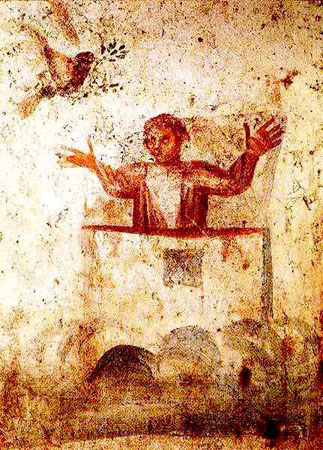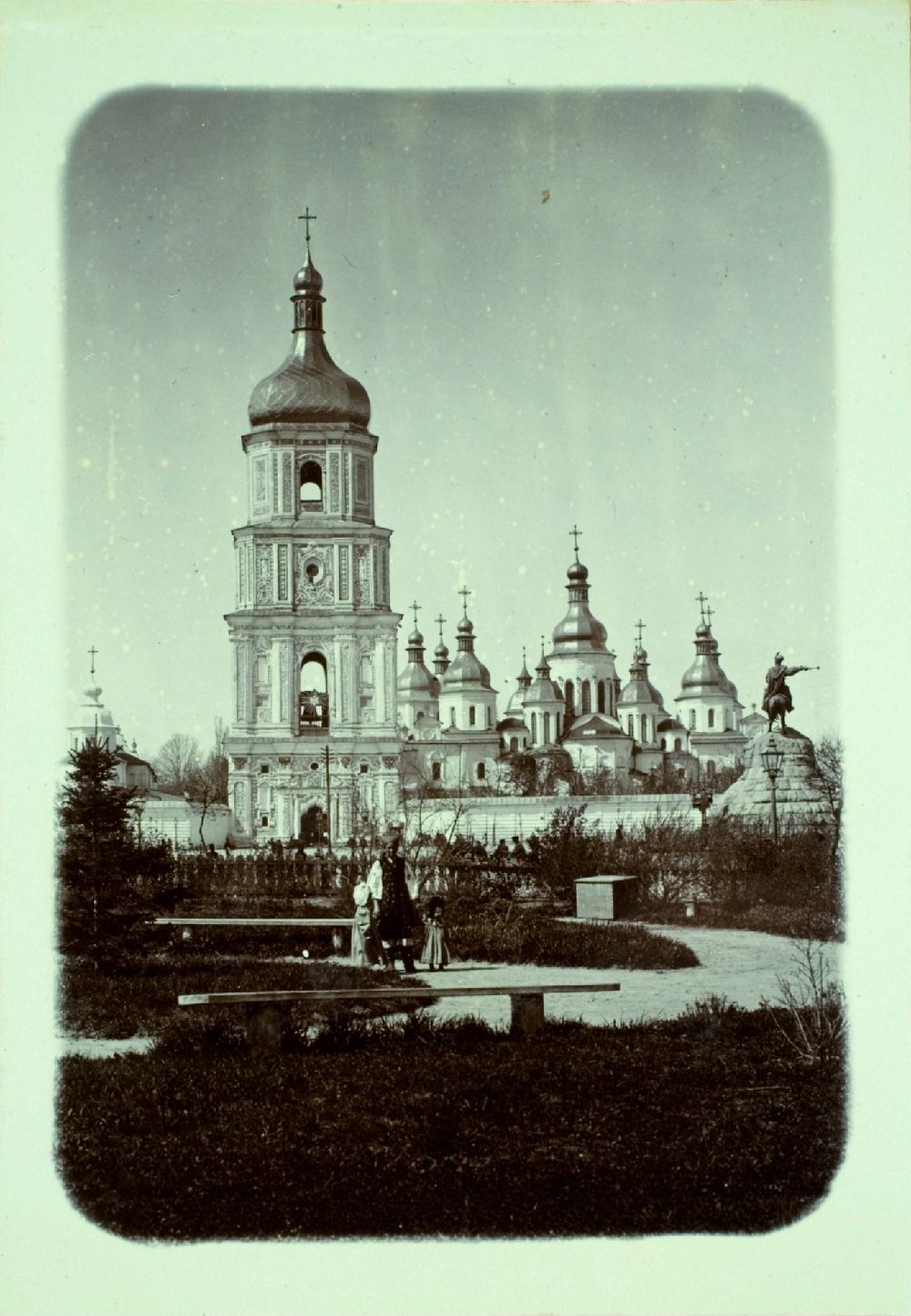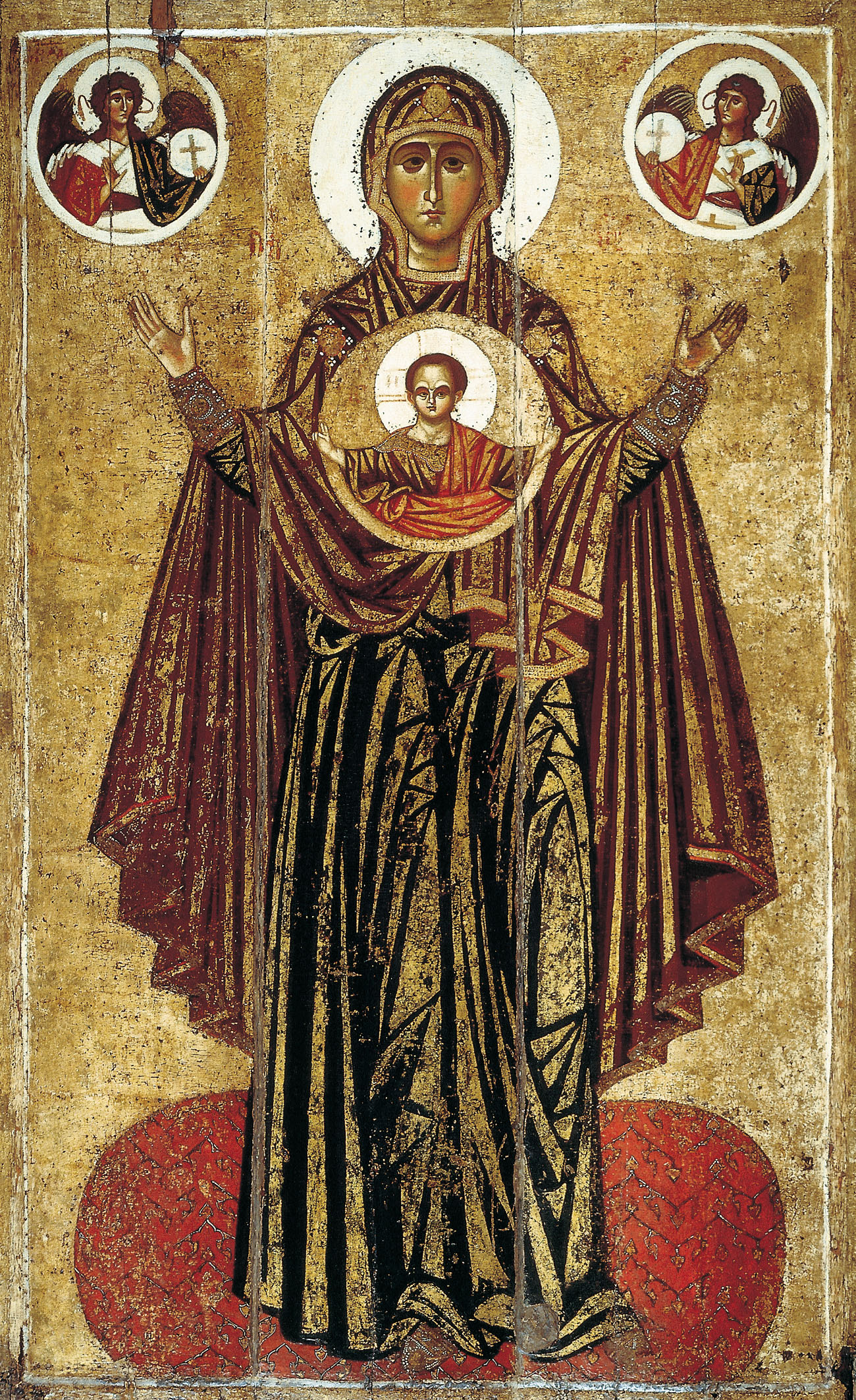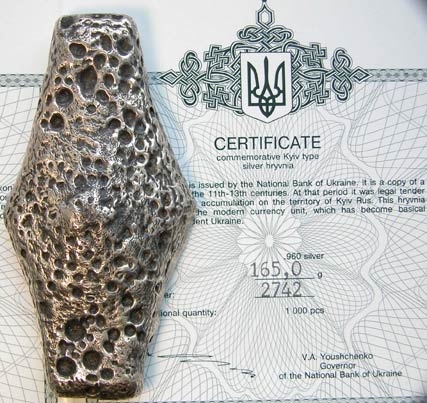|
Oranta
The Virgin Orans, Oranta (The Great Panagia) ( uk, Оранта) is a well-known Orthodox Christian depiction of the Virgin Mary in prayer with extended arms. It is stored in the Saint Sophia Cathedral in Kyiv in Ukraine.''"Предстоятель УПЦ Блаженніший Митрополит Володимир привітав мешканців столиці України з Днем міста", Ukrainian Orthodox Church, May 2010, in Ukrainian'' The 6-meter-high mosaic is located in the vault of the chancel. The icon has been present in the cathedral since its foundation by Yaroslav I the Wise in the 11th century. The Virgin's solemn and static posture, the characteristic folds of her garments, and her pensive expression indicate the design was strongly influenced by Byzantine art. The image is considered one of the greatest sacred symbols in Ukraine, a palladion defending the people of the country. It has been called an "Indestructible Wall" or "Unmoveable Wall". Legen ... [...More Info...] [...Related Items...] OR: [Wikipedia] [Google] [Baidu] |
Orans
Orans (/ˈoː.rans/), a loanword from Medieval Latin ''ōrāns'' translated as ''one who is praying or pleading'', also orant or orante, as well as lifting up holy hands, is a posture or bodily attitude of prayer, usually standing, with the elbows close to the sides of the body and with the hands outstretched sideways, palms up. The orans posture of prayer has a Scriptural basis in : "I desire, then, that in every place the men should pray, lifting up holy hands without anger or argument" (NRSV). It was common in early Christianity and can frequently be seen in early Christian art, being advised by several early Church Fathers, who saw it as "the outline of the cross". In modern times, the orans position is still preserved in Oriental Orthodoxy, as when Coptic Christian believers pray the seven canonical hours of the Agpeya at fixed prayer times; The orans also occurs within parts of the Catholic, Oriental Orthodox, Eastern Orthodox, Lutheran, and Anglican liturgies, Pentecostal ... [...More Info...] [...Related Items...] OR: [Wikipedia] [Google] [Baidu] |
Saint Sophia Cathedral In Kyiv
Saint Sophia Cathedral in Kyiv, Ukraine, is an architectural monument of Kyivan Rus. The former cathedral is one of the city's best known landmarks and the first heritage site in Ukraine to be inscribed on the World Heritage List along with the Kyiv Cave Monastery complex. Aside from its main building, the cathedral includes an ensemble of supporting structures such as a bell tower and the House of Metropolitan. In 2011 the historic site was reassigned from the jurisdiction of the Ministry of Regional Development of Ukraine to the Ministry of Culture of Ukraine. One of the reasons for the move was that both Saint Sophia Cathedral and Kyiv Pechersk Lavra are recognized by the UNESCO World Heritage Program as one complex, while in Ukraine the two were governed by different government entities. It is currently a museum. In Ukrainian the cathedral is known as () or (). The complex of the cathedral is the main component and museum of the National Sanctuary "Sophia of Kyiv" which is ... [...More Info...] [...Related Items...] OR: [Wikipedia] [Google] [Baidu] |
Ukrainian Embroidery
Ukrainian embroidery ( uk, вишивка, ''vyshyvka'') occupies an important place among the various branches of Ukrainian decorative arts. Embroidery has a rich history in Ukraine, and has long appeared in Ukrainian folk dress as well as played a part in traditional Ukrainian weddings and other celebrations.Catherine Amoroso Leslie. ''Needlework Through History: An Encyclopedia ''. Greenwood Press, 2007. Appearing all across the country, Ukrainian embroidery varies depending on the region of origin. From Poltava, Kyiv, and Chernihiv in the east, to Volyn and Polissia in the northwest, to Bukovina, and the Hutsul area in the southwest, the designs have a long history which defines its ornamental motifs and compositions, as well as its favorite choice of colors and types of stitches. History Embroidery is an ancient and symbolic tradition in Ukraine. In 513 BC, Herodotus, the famous Greek historian, in describing the invasion of Darius, mentioned that the Thracian- Da ... [...More Info...] [...Related Items...] OR: [Wikipedia] [Google] [Baidu] |
Panagia
Panagia ( el, Παναγία, fem. of , + , the ''All-Holy'', or the ''Most Holy''; pronounced ) (also transliterated Panaghia or Panajia), in Medieval and Modern Greek, is one of the titles of Mary, mother of Jesus, used especially in Eastern Catholicism and Orthodox Christianity. Most Greek churches dedicated to the Virgin Mary are called ''Panagia''; the standard western Christian designation of "St. Mary" is rarely used in the Orthodox East, as Mary is considered the holiest of all created beings and therefore of higher status than the Saints. Iconography ''Panagia'' is also the term for a particular type of icon of the Theotokos, wherein she is facing the viewer directly, usually depicted full length with her hands in the ''orans'' position, and with a medallion showing the image of Christ as a child in front of her chest. This medallion symbolically represents Jesus within the womb of the Virgin Mary at the moment of the Incarnation. This type of icon is also called t ... [...More Info...] [...Related Items...] OR: [Wikipedia] [Google] [Baidu] |
Palladion
In Greek and Roman mythology, the Palladium or Palladion (Greek Παλλάδιον (Palladion), Latin ''Palladium'') was a cult image of great antiquity on which the safety of Troy and later Rome was said to depend, the wooden statue (''xoanon'') of Pallas Athena that Odysseus and Diomedes stole from the citadel of Troy and which was later taken to the future site of Rome by Aeneas. The Roman story is related in Virgil's ''Aeneid'' and other works. Rome possessed an object regarded as the actual Palladium for several centuries; it was in the care of the Vestal Virgins for nearly all this time. Since around 1600, the word palladium has been used figuratively to mean anything believed to provide protection or safety, and in particular in Christian contexts a sacred relic or icon believed to have a protective role in military contexts for a whole city, people or nation. Such beliefs first become prominent in the Eastern church in the period after the reign of the Byzantine Emp ... [...More Info...] [...Related Items...] OR: [Wikipedia] [Google] [Baidu] |
Eastern Orthodox Icons Of The Virgin Mary
Eastern may refer to: Transportation *China Eastern Airlines, a current Chinese airline based in Shanghai *Eastern Air, former name of Zambia Skyways *Eastern Air Lines, a defunct American airline that operated from 1926 to 1991 *Eastern Air Lines (2015), an American airline that began operations in 2015 *Eastern Airlines, LLC, previously Dynamic International Airways, a U.S. airline founded in 2010 *Eastern Airways, an English/British regional airline *Eastern Provincial Airways, a defunct Canadian airline that operated from 1949 to 1986 *Eastern Railway (other), various railroads *Eastern Avenue (other), various roads *Eastern Parkway (other), various parkways *Eastern Freeway, Melbourne, Australia *Eastern Freeway Mumbai, Mumbai, India *, a cargo liner in service 1946-65 Education *Eastern University (other) * Eastern College (other) Other uses * Eastern Broadcasting Limited, former name of Maritime Broadcasting System, Canada ... [...More Info...] [...Related Items...] OR: [Wikipedia] [Google] [Baidu] |
National Bank Of Ukraine
National Bank of Ukraine ( uk, Національний банк України) or NBU ( uk, НБУ) is the central bank of Ukraine – a government body responsible for unified state policy in the field of country's monetary circulation, including strengthening of the national currency unit, hryvnia. The National Bank of Ukraine employs over 12,000 people, making it one of the leading banks. It regulates and supervises activities, functions and legal status of government and commercial banks based on principles of the Constitution of Ukraine and the law of Ukraine. History Banking in Ukraine traces its history back to 1918 when on 22 December 1917, the Central Council of Ukraine adopted a law "On transformation of the Kyiv office of the Russian State Bank into the Ukrainian State Bank". The law united all offices of the former State bank, Noble Land Bank, and Peasant Land Bank. At the same time there existed a decree of the Central Executive Committee of Ukraine about the natio ... [...More Info...] [...Related Items...] OR: [Wikipedia] [Google] [Baidu] |
Kyiv
Kyiv, also spelled Kiev, is the capital and most populous city of Ukraine. It is in north-central Ukraine along the Dnieper, Dnieper River. As of 1 January 2021, its population was 2,962,180, making Kyiv the List of European cities by population within city limits, seventh-most populous city in Europe. Kyiv is an important industrial, scientific, educational, and cultural center in Eastern Europe. It is home to many High tech, high-tech industries, higher education institutions, and historical landmarks. The city has an extensive system of Transport in Kyiv, public transport and infrastructure, including the Kyiv Metro. The city's name is said to derive from the name of Kyi, one of its four legendary founders. During History of Kyiv, its history, Kyiv, one of the oldest cities in Eastern Europe, passed through several stages of prominence and obscurity. The city probably existed as a commercial center as early as the 5th century. A Slavs, Slavic settlement on the great trade ... [...More Info...] [...Related Items...] OR: [Wikipedia] [Google] [Baidu] |
Theotokos
''Theotokos'' (Greek: ) is a title of Mary, mother of Jesus, used especially in Eastern Christianity. The usual Latin translations are ''Dei Genitrix'' or ''Deipara'' (approximately "parent (fem.) of God"). Familiar English translations are "Mother of God" or "God-bearer" – but these both have different literal equivalents in Greek, Μήτηρ Θεοῦ and Θεοφόρος ("Who gave birth to one who was God", "Whose child was God", respectively). The title has been in use since the 3rd century, in the Syriac tradition (as ) in the Liturgy of Mari and Addai (3rd century)''Addai and Mari, Liturgy of''. Cross, F. L., ed. ''The Oxford Dictionary of the Christian Church''. Oxford University Press. 2005. and the Liturgy of St James (4th century). The Council of Ephesus in AD 431 decreed that Mary is the ''Theotokos'' because Her Son Jesus is both God and man: one divine person from two natures (divine and human) intimately and hypostatically united. The title of Mother o ... [...More Info...] [...Related Items...] OR: [Wikipedia] [Google] [Baidu] |
Yaroslav I The Wise
Yaroslav the Wise or Yaroslav I Vladimirovich; russian: Ярослав Мудрый, ; uk, Ярослав Мудрий; non, Jarizleifr Valdamarsson; la, Iaroslaus Sapiens () was the Grand Prince of Kiev from 1019 until his death. He was also the Prince of Novgorod on three occasions, uniting the principalities for a time. Yaroslav's baptismal name was George ( orv, Гюрьгi, ) after Saint George. Rise to the throne The early years of Yaroslav's life are mostly unknown. He was one of the numerous sons of Vladimir the Great, presumably his second by Rogneda of Polotsk, although his actual age (as stated in the ''Primary Chronicle'' and corroborated by the examination of his skeleton in the 1930s) would place him among the youngest children of Vladimir. It has been suggested that he was a child begotten out of wedlock after Vladimir's divorce from Rogneda and marriage to Anna Porphyrogenita, or even that he was a child of Anna Porphyrogenita herself. French historian Je ... [...More Info...] [...Related Items...] OR: [Wikipedia] [Google] [Baidu] |
Byzantine Art
Byzantine art comprises the body of Christian Greek artistic products of the Eastern Roman Empire, as well as the nations and states that inherited culturally from the empire. Though the empire itself emerged from the decline of Rome and lasted until the Fall of Constantinople in 1453, the start date of the Byzantine period is rather clearer in art history than in political history, if still imprecise. Many Eastern Orthodox states in Eastern Europe, as well as to some degree the Islamic states of the eastern Mediterranean, preserved many aspects of the empire's culture and art for centuries afterward. A number of contemporary states with the Byzantine Empire were culturally influenced by it without actually being part of it (the "Byzantine commonwealth"). These included the Rus, as well as some non-Orthodox states like the Republic of Venice, which separated from the Byzantine Empire in the 10th century, and the Kingdom of Sicily, which had close ties to the Byzantine Empire a ... [...More Info...] [...Related Items...] OR: [Wikipedia] [Google] [Baidu] |






.jpg)

.jpg)
